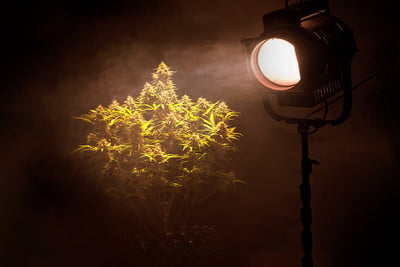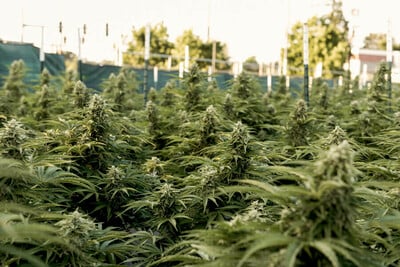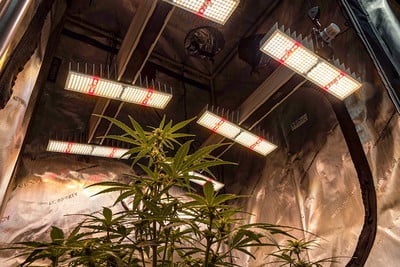.

The Importance of the Dark Cycle for Growing Cannabis
Come join the dark side. In this article, we explore why cannabis plants need the darkness as much as light in order to grow properly.
As dictated by the ancient Chinese philosophy of Yin and Yang, both light and darkness are equally important for the health and harvest of your cannabis plants. Keep reading to learn why darkness is vital to growing great weed.
Contents:
- How important is darkness for cannabis?
- What do cannabis plants do during the dark period?
- How much darkness do cannabis plants need?
- Are all light cycles made equal?
- Do autoflowering cannabis plants need darkness?
- Ways to ensure total darkness for your cannabis plants
- Embrace the darkness to boost your yields
How Important Is Darkness for Cannabis?
Cannabis is a photoperiodic plant species that relies on light cycle changes to grow and reproduce. When the days naturally grow shorter at the end of summer, cannabis plants sense that their life cycle is coming to an end and start to flower in order to produce the next generation of offspring (or seeds). Females produce pistillate flowers (the ones beloved by cannabis growers), and male plants release pollen in order to pollinate the females.
But what happens when we take cannabis out of its natural habitat and cultivate it in an outdoor garden, indoor grow room, or a greenhouse? While there are countless ways in which we can manipulate the way cannabis plants grow, we still have to (or should) abide by some of nature's laws to avoid complete chaos. And that's exactly the case when it comes to darkness.
While as growers we have the ability to maximise the growth of our plants using special lighting, nutrients, training techniques, and even extended light cycles, one thing remains certain—cannabis plants need at least some moments of darkness to grow properly and produce the flowers we treasure. Without a healthy light/dark cycle, cannabis plants may not start flowering at all or demonstrate signs of stress, such as stunted growth, poor flower production and structure, or hermaphroditism.
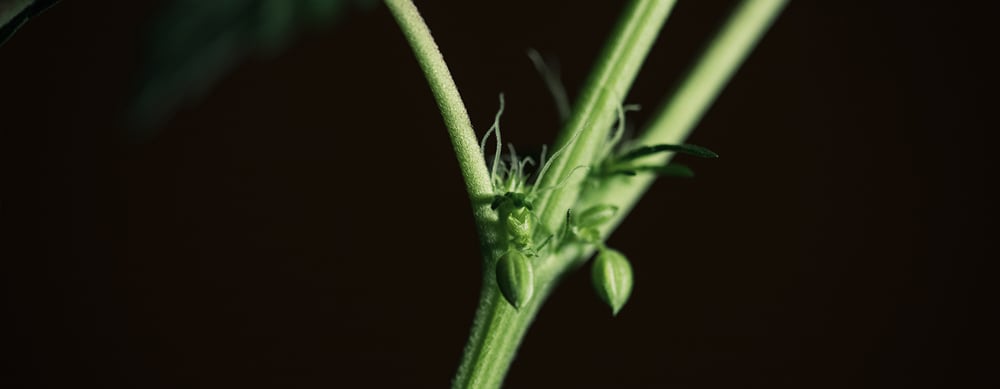
What Do Cannabis Plants Do During the Dark Period?
Cannabis, like all green plants, photosynthesises when it receives light (be it from the sun or from a grow light). Using light energy as fuel, plants are able to take water and carbon dioxide from their environment and turn them into glucose and oxygen. At the same time, plants also respire, releasing surplus oxygen into the environment while simultaneously breaking down the sugars produced during photosynthesis into usable energy.
In the dark, plants use the energy they produce during the day (or in the presence of light) to turn carbon dioxide from the environment into glucose and other simple sugars that they can use to help further fuel their growth. At the same time, respiration also occurs during the dark cycle—just like us, plants only stop respiring when they're dead or dying!
How Much Darkness Do Cannabis Plants Need?
Cannabis plants need different amounts of darkness during different stages of their life cycle.
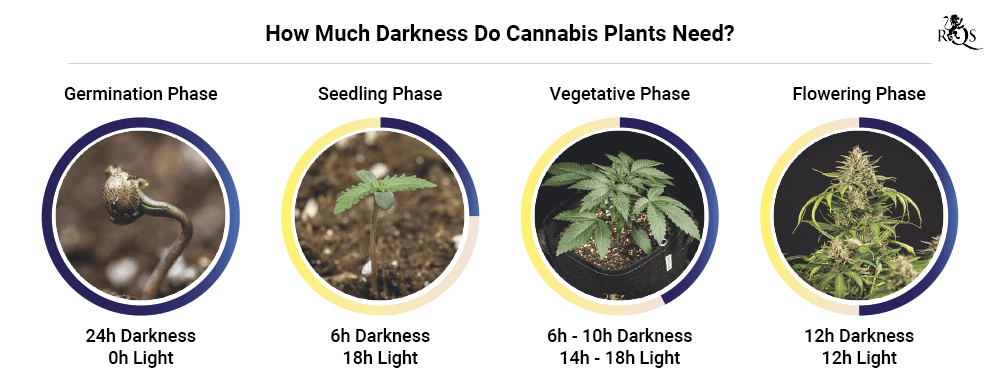
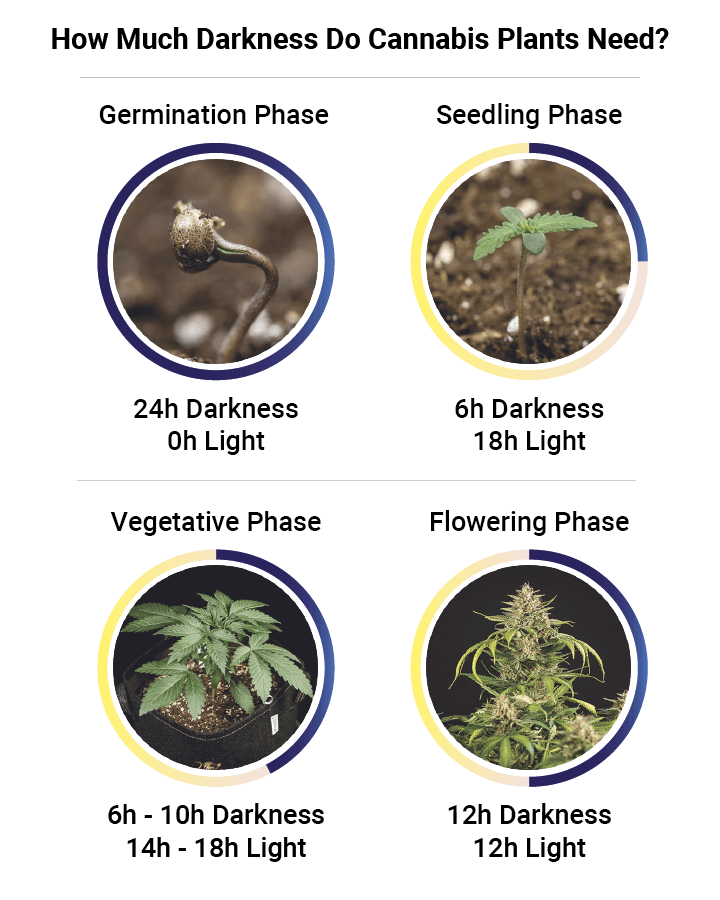
Germination / Seedling Phase
Light is not a strict requirement for seed germination. The three main requirements needed to germinate cannabis seeds are water, oxygen, and the right temperature, and most growers opt to germinate their seeds in the dark. However, light becomes very important as soon as a seed sprouts. Without adequate lighting, cannabis seedlings can quickly become leggy, which can leave them fragile and prone to falling over or damping off.
Cannabis seedlings should be exposed to high-quality, cool light for around 18 hours per day. Make sure to place your lights around 5cm from the tops of your seedlings to promote healthy growth and avoid stretching/legginess (i.e. etiolation).
Vegetative Phase
Photoperiod cannabis plants need at least 14+ hours of light per day in order to stay in the vegetative phase. Now, exactly how many light hours you choose to give your plants is up to you; in fact, growers readily debate this topic all the time. In general, however, most growers opt to give their plants 18 hours of light followed by 6 hours of uninterrupted darkness during the vegetative phase.
That said, some growers opt to veg their plants under 24 hours of continuous light, and achieve good results. Besides a hefty power bill, however, a 24-hour light cycle may produce stress in some plants, which can result in poor growth and subsequently a poor harvest.
Alternatively, some growers choose to keep their plants under 6/2 cycles—that is, 6 hours of light followed by 2 hours of darkness. After three repetitions of this cycle, the plants will have received 18 hours of light and 6 hours of darkness, but some growers argue that the short breaks allow the plants to rest and process CO₂ more effectively.
Moreover, plants that are grown in 6/2 cycles won't flower, as photoperiod cannabis needs to be exposed to 12 hours of continuous darkness in order to enter their bloom phase.
Flowering Phase
In order to flower, photoperiod cannabis plants need to sense that winter is coming—literally. To simulate this in an indoor room or tent, you'll need to dial back your light hours. Again, there's a lot of debate about the perfect ratio of light and darkness for flowering cannabis plants, but most growers opt for a 12/12 light/dark cycle.
Note: Cannabis plants won't flower immediately after you change your light cycle, and many growers suggest gradually decreasing a plant's light hours to ease them into the bloom phase without causing them any stress. Others, however, opt for a more abrupt change, leaving their plants in complete darkness for up to 36 hours before switching to 12/12 lighting in order to ensure an effective transition from veg to bloom.
Why Put Cannabis in the Dark Just Before Harvest?
It's harvest time and your plants are heavy with sweet flowers. Time to cut 'em down, right? Not according to some growers. A large number of cannabis cultivators recommend subjecting harvest-ready plants to 24 hours of darkness (or even 48 hours) before cutting them down. The argument here is that the sudden light deprivation stresses the plants, causing them to produce more resin, and thus more THC and terpenes.
Unfortunately, this theory has not been proven. And while some growers claim to experience success with the methods, we recommend you take those results with a grain of salt, as many variables could have influenced them.
Are All Light Cycles Made Equal?
While some growers like to experiment with different light cycles (as we saw above), most indoor growers follow an 18/6 cycle during veg and a 12/12 cycle during bloom. Similarly, most outdoor growers plant their seeds nice and early in the season to make the most of the long days and maximise their plants' vegetative growth.
But do these standard practices really ensure the best results come harvest time? Research from Australia[1] suggests that maybe not. In an article from 2023, researchers from New South Wales Department of Primary Industries, The University of Melbourne, and Southern Cross University studied the effects of different light cycles on the yield and cannabinoid production of different cannabis varieties.
The researchers tested the effects of different light cycles (12/12, 10/14, and 14/10) on three varieties of cannabis—Cannatonic (a high-CBD strain), Northern Lights, and Hindu Kush (both high-THC strains). They found that plants that began flowering under a 14/10 cycle produced the heaviest yields, and Cannatonic produced between 50–100% more CBD under these conditions. Meanwhile, the two high-THC strains produced notably less THC under the 14/10 cycle, despite producing more flowers.
Many growers are familiar with how sensitive cannabis is to light. This research, however, suggests that light sensitivity may vary among different cannabis varieties, and further research like this could help to identify new approaches to light cycle management beyond the standard 18/6 for veg and 12/12 for bloom, bringing out the best results in different cannabis varieties.
Do Autoflowering Cannabis Plants Need Darkness?
Autoflowering cannabis plants are derived from Cannabis ruderalis, a unique cannabis variety that flowers based on age rather than in response to light cycle changes. Since autos are not photoperiodic, many growers have been led to believe that these varieties can (or even should) be grown under 24 hours of light from seed to harvest in order to maximise plant growth and yields. However, we advise against this.
As we saw at the beginning of this article, many key plant processes occur during the dark phase. Moreover, nowhere on Earth except the Arctic (where cannabis doesn't grow naturally) do we see plants exposed to 24 hours of light per day. And we tend to think that nature knows best, which is why we choose to grow autos under a 18/6 light/dark cycle, and recommend you do the same.
Ways to Ensure Total Darkness for Your Cannabis Plants
To maximise the health of your plants and the size and quality of their yields, it is important that your grow space is free of light pollution. Failure to ensure this can result in stress and even the revegetation of blooming cannabis plants. If you're growing indoors, the best way to do this is to invest in a quality light-proof tent. If you're growing outdoors, make sure to keep your garden lighting off during the night. Also, if you live in a densely populated area (such as a city), keep your plants as far away as possible from any other sources of light (streetlights, your neighbours' garden lighting fixtures, etc.).
Embrace the Darkness to Boost Your Yields
As cannabis growers, we're often tempted to "play God" and manipulate our plants to achieve bigger harvests. At RQS, however, we prefer to grow cannabis the way nature intended, which is why we recommend giving your plants a good dose of darkness just like they'd enjoy when growing out in nature. Do this, and you'll be sure to grow healthy plants and harvest spectacular buds.
- Plants | Free Full-Text | Moving Away from 12:12; the Effect of Different Photoperiods on Biomass Yield and Cannabinoids in Medicinal Cannabis https://www.mdpi.com


























